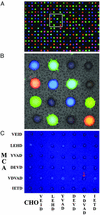Printing chemical libraries on microarrays for fluid phase nanoliter reactions
- PMID: 12851459
- PMCID: PMC166379
- DOI: 10.1073/pnas.1530261100
Printing chemical libraries on microarrays for fluid phase nanoliter reactions
Abstract
Chemical compounds within individual nanoliter droplets of glycerol were microarrayed onto glass slides at 400 spots/cm2. Using aerosol deposition, subsequent reagents and water were metered into each reaction center to rapidly assemble diverse multicomponent reactions without crosscontamination or the need for surface linkage. This proteomics technique allowed the kinetic profiling of protease mixtures, protease-substrate interactions, and high-throughput screening reactions. An inhibitor of caspases 2, 4, and 6 was identified by using a 352-compound combinatorial library microarrayed in quadruplicates on 100 slides and screened against caspases 2, 4, and 6, as well as thrombin and chymotrypsin. From one printing run that consumes <1 nanomole of each compound, large combinatorial libraries can be subjected to numerous separation-free homogeneous assays at volumes 103-104 smaller than current high-throughput methods.
Figures




References
-
- MacBeath, G. & Schreiber, S. L. (2000) Science 289, 1760–1763. - PubMed
-
- Zhu, H., Klemic, J. F., Chang, S., Bertone, P., Casamayor, A., Klemic, K. G., Smith, D., Gerstein, M., Reed, M. A. & Snyder, M. (2000) Nat. Genet. 26, 283–289. - PubMed
-
- Zhu, H. & Snyder, M. (2001) Curr. Opin. Chem. Biol. 5, 40–45. - PubMed
-
- Zhu, H., Bilgin, M., Bangham, R., Hall, D., Casamayor, A., Bertone, P., Lan, N., Jansen, R., Bidlingmaier, S., Houfek, T., et al. (2001) Science 293, 2101–2105. - PubMed
-
- Kuruvilla, F. G., Shamji, A. F., Sternson, S. M., Hergenrother, P. J. & Schreiber, S. L. (2002) Nature 416, 653–657. - PubMed
Publication types
MeSH terms
Substances
Grants and funding
LinkOut - more resources
Full Text Sources
Other Literature Sources

